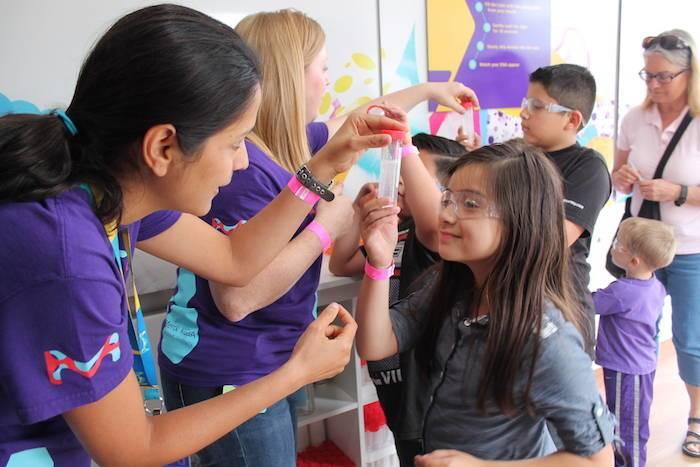
By Jeffrey Whitford
I often envy what the world looks like through the eyes of a child. Even the simplest things can make a child curious. This inquisitive mindset enables them to get lost in exploration without caring about what needs to get done, because the definition of “need” is different for a child.
Being able to revert to this child-like perspective ultimately led to one of the biggest “aha” moments that we in the Corporate Responsibility group at MilliporeSigma have had. We realized that perception and access are more than half of the battle when it comes to getting children interested in science, so we set out on a mission to try and solve that problem.
One of our team members had an idea that, at the time, seemed off-the-wall. He suggested painting a retrofitted shipping container bright yellow, adding in some additional vibrant colors and interesting shapes in the form of our own “microbes” to create a mobile science lab that could go anywhere. This mobility would allow students to freely engage with hands-on science—bringing access to those who would not have had this opportunity through their schools. This strange-looking, brightly-colored shipping container became MilliporeSigma’s Curiosity Cube.
Throughout 2017, the Curiosity Cube has made several stops around the country—and over the past month alone, it has traveled throughout Missouri and Wisconsin. Upcoming Curiosity Cube stops include Ohio, Pennsylvania and New Hampshire.
During the tour, we spend days, weeks or even a month in a city—sparking curiosity in the next generation of scientists and encouraging more of today’s youth to consider a career in science, technology, engineering and math (STEM). Through hands-on science experiments, students entering the Curiosity Cube can learn about DNA extraction, precision medicine and 3D printing right in their own community.
While a visually engaging exterior is the key to sparking interest, the most important part—the part that leaves a lasting impact—is having the right content, people and experiences inside the Curiosity Cube to not only capture the attention of children, but also to jumpstart their curiosity and empowerment. We partnered with Washington University’s Institute for School Partnership to map out experiences building on our popular Curiosity Labs program. Through Curiosity Labs, researched-based science lessons covering a variety of topics are conducted in classrooms by our own team of trained MilliporeSigma employees, who demonstrate that anyone can be a scientist, regardless of gender, ethnicity or race. We know that statistically, women and people of color are underrepresented in the sciences. If you ask children what they think a scientist looks like, the most frequent answer is “an old white guy with wild hair”—they’re imagining Albert Einstein instead of self-identifying. This limiting viewpoint thwarts us from potential discoveries, powerful collaborations and the opportunity for any child to pursue a dream because they don’t “see” themselves or anyone who looks like them as a scientist. Knowing this, our diverse group of employees uses opportunities such as our Curiosity Labs to connect with these children—ultimately helping to change their perspective and then self-identify as a future scientist.
By taking the lessons learned from our Curiosity Labs program and adding some extra bells and whistles to expose students to some of today’s most sophisticated technology, we’re able to help students connect problem-solving with the real world. Our team of scientists engages with students by sharing how the experiments in the Curiosity Cube are similar to what they do every day—connecting academia to industry, which is often a missing, critical element. The Curiosity Cube benefits not only the students, but also our own local staff, who volunteer their time and talents each day. Both employee engagement and pride in the workplace have increased as a result of the Curiosity Cube program and all of our employees said that they would volunteer again. One employee from our St. Louis team said, “The Curiosity Cube is the coolest project I've seen a company implement and I'm so happy to work here.” This speaks to not only the environment created, but what they’re seeing happen with the students that they work with.
We’re very interested in the meaningful learning happening inside the Curiosity Cube. While we realize that this short-term experience isn’t going to be like taking a year-long, middle school physical science class, we do want to track and measure what students are learning and taking away so that we can create the most meaningful experience possible.
Through our surveys of children following their experience, we’ve found that:
- 76 percent of students were able to answer the question “what does the cerebellum control” correctly
- 70 percent of students answered “what does DNA stand for” correctly
- 77 percent of students said they are now more interested in science
- 74 percent of students felt more curious following their Curiosity Cube
We’ve also had some great questions and “aha” moments from the students who have come through the cube. One fourth-grade student told us, “I just never realized how important science was until today!”
We view what we’re doing as an investment in the next era of STEM-capable problem solvers—those who will help to solve some of the world’s biggest challenges. From our founding membership in the STEMpact collaborative in St. Louis to the Sigma-Aldrich Science Partners program, which is now globally known as Curiosity Labs and our Curiosity Cube, we’re committed to helping educate the next generation of scientists—right here in the U.S. and abroad.
Who knows, maybe one of those problem solvers will have gotten their start in this strange-looking yellow shipping container.
Jeffrey Whitford is head of global corporate responsibility for MilliporeSigma.
Image credit: MilliporeSigma
TriplePundit has published articles from over 1000 contributors. If you'd like to be a guest author, please get in touch!














